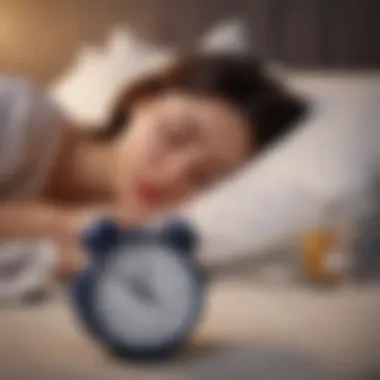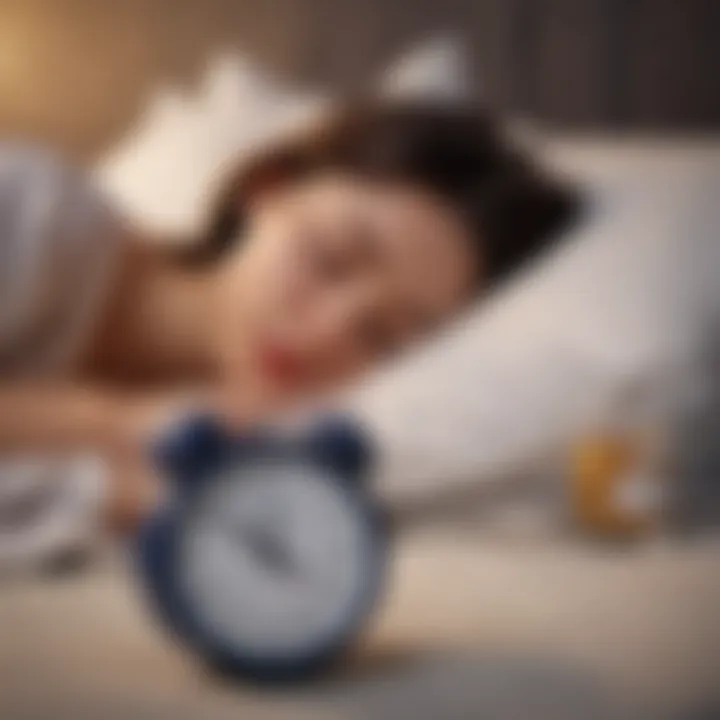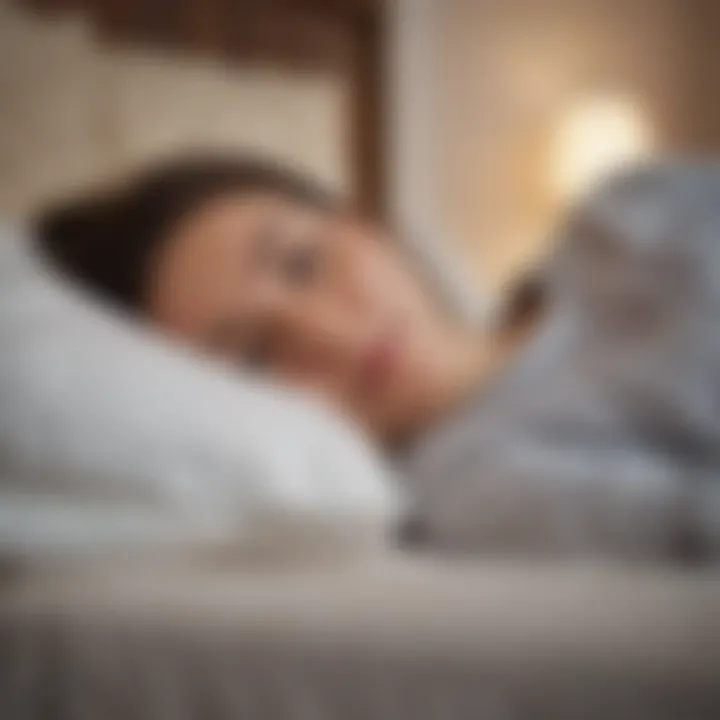Understanding the Sleep Test Quiz: A Comprehensive Guide


Intro
Understanding sleep is critical for overall health. The sleep test quiz serves as a useful tool for evaluating one’s sleep patterns and potential disorders. This article explores the significance of the sleep test quiz, its methodologies, and its effect on sleep health.
The sleep test quiz acts as a primary assessment for identifying sleep issues. Many individuals underestimate the impact that poor sleep can have on daily functioning, including physical health and mental clarity. This guide aims to provide insights into various factors affecting sleep, thus helping you take informed steps toward better sleep quality.
Wellness
Physical Health
Sleep is not simply a break from wakefulness; it is vital for physical health. It plays an important role in processes such as tissue repair, immune function, and hormonal balance. Many studies have shown that inadequate sleep is linked to increased risk of chronic conditions like obesity, diabetes, and heart disease. Understanding your sleep quality through the quiz can lead to early detection and prevention of these health risks.
Mental Health
The relationship between sleep and mental health is significant. Poor sleep can exacerbate conditions such as anxiety and depression. High-quality sleep helps in emotional regulation and cognitive functioning. Engaging in a sleep test quiz allows individuals to assess their mental health concerning their sleep. Gathering this data aids in seeking targeted help if needed.
Nutrition and Diet
Sleep and nutrition are interconnected. Consuming a diet rich in tryptophan, magnesium, and vitamins can promote better sleep. Certain foods, like bananas and nuts, have benefits for enhancing sleep quality. The sleep test quiz may guide individuals to identify their dietary habits that are either conducive or detrimental to sleep, paving the way for better dietary choices.
Fitness and Exercise
Regular physical activity contributes significantly to improved sleep patterns. Exercise helps regulate circadian rhythms and increases the duration of deep sleep. By participating in a sleep test quiz, individuals can understand their activity levels and how it correlates with their sleep quality. Proper exercise routines can thus be developed based upon individual needs.
Importance of the Sleep Test Quiz
The sleep test quiz provides a platform for individuals to gather vital information about their sleep health. It offers insights into patterns, behaviors, and potential disruptions in sleep cycles. This data is vital for understanding how lifestyle choices influence sleep and can also inform further medical evaluations if necessary.
"Quality sleep is the foundation for a healthy life; understanding your sleep patterns is the first step toward improvement."
Significance in Assessing Sleep Disorders
Identifying symptoms of sleep disorders is crucial. The sleep test quiz is designed to highlight various issues, such as insomnia or sleep apnea. Knowledge of these conditions allows for timely medical interventions and personalized treatment options, improving overall well-being.
Practical Steps for Individuals
For individuals considering taking a sleep test quiz, it is essential to approach the process thoughtfully. Here are a few recommendations:
- Maintain a sleep diary for a week prior.
- Be honest when answering the questions.
- Highlight lifestyle factors that affect sleep—like caffeine or stress.
- Follow-up with a healthcare professional to discuss results.
Prelude to Sleep Testing
Sleep testing is a critical process for understanding sleep health. As sleep disorders become more prevalent, the significance of assessing one's sleep quality and patterns has grown. Those struggling with various sleep issues may not realize the underlying conditions affecting their rest. The introduction of sleep testing opens a pathway for evaluation and potential solutions to improve individual well-being.
People often experience confusion regarding their sleep state. The importance of sleep testing lies in its ability to bring clarity. Through structured assessments, healthcare providers can identify issues like sleep apnea, insomnia, or restless legs syndrome. These evaluations go beyond just measuring duration; they provide insights into the overall quality of sleep, which is essential for cognitive function and emotional stability.
Testing can also offer relief. For individuals who have not found success with self-help remedies or over-the-counter solutions, a thorough examination can reveal specific problems. This can lead to better-targeted treatments, enhancing the quality of life.
In summary, understanding sleep testing is not just about recognizing its definition and purpose. It lays the groundwork for realizing the profound effects that sleep quality can have on health. As the article progresses into different types of tests and their implementations, it is crucial to grasp the value of sleep assessments in navigating sleep-related challenges.
Types of Sleep Tests
Understanding the different types of sleep tests is crucial for evaluating sleep health. Each type serves a unique function and helps in identifying specific sleep disorders. By knowing the available options, individuals can make informed decisions regarding their sleep assessments. Proper testing can lead to effective treatment plans and improvements in overall well-being.
Polysomnography
Polysomnography is considered the gold standard in sleep testing. This comprehensive sleep study is conducted in a sleep laboratory and collects a wide range of data. It measures brain waves, oxygen levels, heart rate, and breathing patterns. Additionally, it records eye and leg movements.
The results from polysomnography provide a detailed overview of sleep stages and any disturbances that may occur. It is particularly effective for diagnosing apnea, REM sleep behavior disorder, and narcolepsy. However, this type of testing can be expensive and may involve overnight stays in a clinic.
Home Sleep Apnea Testing
Home sleep apnea testing, or HSAT, offers a more accessible alternative for many. This method allows the individual to monitor themselves in their familiar environment. The setup typically involves a portable device that measures several parameters, such as airflow, oxygen saturation, and heart rate, while the patient sleeps.
While HSAT is less comprehensive than polysomnography, it is a valuable option for suspected obstructive sleep apnea. Patients who are uncomfortable with overnight laboratory testing may find this method appealing. However, it is generally not suitable for identifying multiple sleep disorders or complex cases.
Actigraphy
Actigraphy involves wearing a small device, similar to a wristwatch, that tracks movement over a period of time. This method can help determine sleep patterns and overall sleep quality. It is particularly useful for individuals who have trouble maintaining regular sleep schedules or have insomnia.
Data from actigraphy can show sleep durations, the number of awakenings during the night, and rest-activity cycles. It is a non-invasive and practical tool but may not provide detailed information regarding sleep architecture. It can serve as an adjunct to other sleep testing methods for a comprehensive assessment of sleep behavior.
Overall, choosing the right type of sleep test depends on individual needs, concerns, and preferences. By understanding the options available, patients can seek the most appropriate assessment for their conditions.
The Sleep Test Quiz Explained
The sleep test quiz serves as a valuable tool for assessing one's sleep patterns and possible disorders. Its importance lies in identifying potential issues before they escalate. Many individuals struggle with sleep problems but may not recognize the symptoms or their severity. This quiz can help illuminate patterns related to sleep health. By providing insights into an individual's sleep habits, it facilitates the conversation with healthcare professionals.
Purpose of the Quiz
The primary objective of the sleep test quiz is to evaluate the quality and efficiency of sleep. It prompts individuals to reflect critically on their habits and symptoms. Importantly, the quiz is not a diagnostic tool but rather a preliminary step in understanding sleep issues. It assists in recognizing if further testing is necessary.
Key purposes include:


- Identifying Symptoms: The quiz can highlight common indicators of sleep disorders, such as snoring, excessive daytime sleepiness, and difficulty falling asleep.
- Guiding Decisions: Based on the quiz results, participants can make informed decisions about seeking professional help.
- Raising Awareness: Participants may become more conscious of their sleep habits and how these affect their overall well-being.
How the Quiz Functions
Generally, the sleep test quiz consists of a series of questions related to a person's sleep experiences. The questions are designed to evaluate various factors affecting sleep quality. Responses typically focus on:
- Sleep Duration: How many hours of sleep do you average nightly?
- Sleep Quality: How often do you wake up feeling rested?
- Disruptive Behaviors: Are there instances of sleepwalking or frequent awakening?
After completing the quiz, the scoring system interprets the answers. A higher score may indicate a higher likelihood of experiencing sleep disorders, suggesting the need for further evaluation.
"Effective sleep assessment begins with meaningful questions that reveal the underlying problems."
This information serves as a significant starting point. For individuals who score in a concerning range, it is advisable to consult a specialist.
Ultimately, the quiz offers a structured framework to discuss sleep health, fostering a proactive approach to well-being.
Criteria for a Sleep Test Quiz
Effective sleep test quizzes have well-defined criteria that impact their overall utility. Understanding these criteria allows individuals to engage meaningfully with their sleep health. A well-constructed quiz provides clear insights that can lead to appropriate interventions or guidance.
Question Design
The design of questions in a sleep test quiz plays a crucial role in capturing relevant information about sleep patterns. Each question should be straightforward, targeting specific aspects of the sleep experience. For instance, questions might probe into the duration of sleep, frequency of disturbances, and overall satisfaction with sleep quality. Factors to consider include:
- Clarity: Questions must avoid technical jargon to ensure comprehension.
- Relevance: Each question should directly relate to common sleep issues such as insomnia or sleep apnea.
- Variety: Including multiple-choice, true/false, and open-ended questions can gauge different dimensions of sleep patterns.
The accuracy of responses relies heavily on how questions are framed; ambiguity can lead to misleading conclusions.
Scoring Methodology
Scoring methodology is critical in interpreting the results of the quiz. A transparent and direct scoring system enhances the reliability of the insights generated. A few key points about scoring include:
- Scoring Scale: Implement a standardized scoring scale that clearly correlates with sleep quality. For example, a 1-10 scale can help quantify sleep disturbances or satisfaction levels.
- Thresholds: Establish thresholds for various categories such as mild, moderate, or severe sleep issues. This helps individuals recognize the need for further evaluation.
- Feedback Loop: Providing immediate feedback based on scores allows users to reflect on their results and consider next steps, such as seeking professional advice.
In summary, a well-designed sleep test quiz emphasizes clarity in question design and a coherent scoring methodology. These elements together facilitate meaningful assessments of sleep health, supporting individuals seeking to understand and improve their sleep quality.
Interpreting Sleep Test Results
Interpreting sleep test results is a pivotal step in understanding one's sleep health. The insights gained from these results can lead to appropriate treatment options and enhance overall well-being. Understanding the output of sleep tests helps clinicians diagnose specific sleep disorders and refine their methods of care.
Sleep tests provide data on various physiological metrics during sleep, such as brain wave activity, heart rate, and breathing patterns. This information is essential for identifying conditions like sleep apnea, insomnia, and other sleep-related disorders. By examining these metrics, specialists can discern patterns that might not be evident through subjective reporting alone.
Common Sleep Disorders
Common sleep disorders observed through sleep tests include:
- Insomnia: This disorder manifests as difficulties in falling or staying asleep. It can be transient or chronic and impacts daily functioning.
- Sleep Apnea: Characterized by interrupted breathing during sleep, sleep apnea can lead to significant health issues if undiagnosed and untreated.
- Restless Legs Syndrome: This condition involves an uncontrollable urge to move the legs, particularly during the evening. It often disrupts sleep quality and duration.
- Periodic Limb Movement Disorder: Involves involuntary leg movements during sleep, causing sleep disturbances.
These disorders not only disrupt sleep but also can lead to broader health repercussions such as increased risk of cardiovascular diseases and mental health issues. Effective interpretation of sleep test results allows for the identification of these disorders and subsequent intervention.
Identifying Patterns
Identifying patterns within sleep test results is essential for clinicians. It involves analyzing various data points captured during sleep:
- Sleep Cycle Analysis: Understanding the progression through sleep stages can reveal how deeply a person sleeps and highlights any disruptions that may occur.
- Breath Monitoring: Examining fluctuations in breathing can assist in diagnosing sleep apnea severity and the presence of other respiratory issues during sleep.
- Heart Rate Variability: Assessing heart rate changes provides insights into how the body responds to different sleep states.
Clarity in these patterns not only aids in diagnosing sleep disorders but also contributes to personalization of treatment strategies. By tailoring interventions based on the specific patterns observed, individuals can potentially achieve better sleep outcomes.
"Interpreting sleep test results requires a detailed understanding of sleep physiology and careful analysis to ensure accurate diagnoses and effective treatment plans."
The Role of Sleep Quality in Health
Sleep is a fundamental part of human life, influencing various physiological and psychological functions. The quality of sleep significantly affects health. Poor sleep quality can lead to numerous complications. Understanding this can help individuals take proactive measures in improving their overall well-being.
Effects of Sleep Deficiency
Sleep deficiency negatively impacts the body in multiple ways. Individuals may experience increased fatigue, reduced cognitive function, and impaired decision-making abilities. Additionally, chronic sleep deprivation can elevate the risk of serious conditions like obesity, diabetes, and cardiovascular diseases.
- Fatigue and Alertness: Lack of sleep contributes to continual tiredness. This can result in slower reaction times and decreased attention spans. Most people may not realize this decline until an episode of drowsiness affects their daily activities.
- Metabolic Issues: Studies have shown a correlation between sleep deficiency and metabolic health. Inconsistent sleep patterns may lead to weight gain through hormonal imbalances. Leptin and ghrelin, hormones that regulate hunger and appetite, are particularly affected.
- Immune Function: A well-rested body cultivates a strong immune response, while sleep deficiency weakens it. This increases susceptibility to infections and illnesses. Good sleep creates a balance essential for bodily repair and maintenance.
"Sleep deficiency is a public health epidemic that affects physical health, emotional well-being, and community safety."
Correlation with Mental Health
A clear relationship exists between sleep quality and mental health. Sleep issues often accompany conditions such as anxiety and depression. Conversely, poor mental health can lead to disturbances in sleep patterns, creating a detrimental feedback loop.
- Mood Regulation: Quality sleep is critical for emotional regulation. Lack of sleep can exacerbate feelings of irritability and sadness. Conversely, adequate rest bolsters mood stability and resilience to stressors.
- Cognitive Function: Sleep is essential for memory retention and learning. Without sufficient sleep, cognitive processes, including problem-solving skills and creativity, may be hindered. This can have notable consequences, especially in children and adolescents.
- Increased Anxiety and Depression: Studies suggest that sleep deprivation can increase the risk of developing anxiety disorders and further aggravate existing depression. Understanding this correlation is essential for mental health management.
In summary, sleep quality plays a vital role in maintaining both physical and mental health. Addressing sleep deficiency not only improves daily functioning but also contributes to the prevention of many health issues.
Preparing for a Sleep Test
Preparing for a sleep test is a crucial step in understanding one's sleep health. This preparation typically enhances the accuracy of the test results, ensuring that any underlying issues are effectively identified. A well-prepared individual usually experiences a smoother testing process.
Proper preparation includes understanding the guidelines and instructions provided by healthcare professionals. This knowledge allows for an informed approach to the test. Individuals often feel more comfortable and less anxious when they know what to expect. Additionally, awareness of pre-test requirements helps to alleviate potential obstacles that might affect the quality of the results.


The benefits of a successful prep process cannot be understated. Not only does it result in clearer outcomes, but it also aids in establishing a meaningful dialogue between the patient and the healthcare provider. This connection is essential for tailoring treatment protocols post-assessment.
Pre-Test Instructions
Pre-test instructions play a significant role in the effectiveness of a sleep test. The guidance usually includes specifics such as medication adjustments, dietary restrictions, and lifestyle practices. These fine details are often essential to ensure an accurate evaluation of sleep patterns.
- Avoid Stimulants: It is typically advised to refrain from caffeine and nicotine for at least 24 hours prior to the test. These substances can disrupt sleep architecture and compromise test integrity.
- Medications: Patients are often instructed to consult their healthcare provider about their current medications. Some may need to be adjusted or temporarily discontinued to avoid skewing results.
- Sleep Schedule: Maintaining a consistent sleep schedule in the days leading to the test is encouraged. This approach ensures the body is in a balanced state, thus providing a better understanding of sleep habits.
- Clothing and Accessories: Patients are generally advised to wear comfortable clothing and to avoid heavy makeup or creams on the night of the test. Comfort aids relaxation, which might be critical for the results.
What to Expect During the Test
Understanding what to expect during a sleep test can mitigate anxiety and foster a sense of control. Generally, the experience varies based on the type of test conducted, whether it is an overnight polysomnography at a sleep center or a home sleep apnea test.
During a polysomnography, several sensors are attached to the patient. This non-invasive process monitors various physiological parameters such as brain waves, oxygen levels, heart rate, and movement throughout the night. Patients typically lie in a comfortable bed, in a dimly lit room, which has been designed to mimic home sleep conditions to some extent.
For a home sleep apnea test, the process is generally more straightforward. Patients receive a portable monitoring device to use within their home environment. The device usually tracks key indicators like breathing patterns and oxygen levels.
"Being aware of the setup, sensor placements, and being informed helps demystify the process. This knowledge fosters a more relaxed mindset, potentially improving the test outcome."
Overall, both setups are designed to facilitate as natural a sleep experience as possible, thus improving the reliability of the data collected.
Post-Test Considerations
After undergoing a sleep test, there are several important elements to consider. Understanding the outcomes can shape future health decisions and improve overall sleep quality. The significance of evaluating your post-test experience cannot be understated. Not only does it provide insight into your sleep patterns, but it also serves as a foundation for treatment or lifestyle changes that can enhance your health.
Understanding Your Report
Upon receiving your sleep test report, take time to digest the information. This document details various metrics related to your sleep. It may include data on sleep stages, apnea episodes, oxygen levels, and overall sleep efficiency. Familiarizing yourself with these terms is essential. For example:
- Apnea Index: Indicates the severity of sleep apnea based on the number of episodes.
- Sleep Latency: The time it takes for you to transition from wakefulness to sleep.
- Oxygen Saturation Levels: A critical measure for understanding respiratory function.
Understanding your report can empower you to address the issues identified. It’s advisable to consult with a healthcare provider to interpret the report accurately. They can explain what the findings mean for your specific situation and suggest next steps.
Follow-Up Steps
Following the review of your sleep report, the next steps are crucial. You might consider consulting with a sleep specialist for a deeper analysis. This might include a more detailed discussion about treatment options, if necessary. Here are some recommended follow-up actions:
- Schedule a Consultation: Discuss the report with a healthcare professional specializing in sleep disorders. They can provide personalized advice tailored to your conditions.
- Implement Suggested Changes: If certain behaviors or habits are harmful to your sleep, consider making adjustments. For instance, establish a consistent sleep schedule or modify the sleep environment.
- Consider Further Testing: Sometimes, additional sleep studies may be necessary, especially if initial results were inconclusive.
- Utilize Support: Seek help from sleep coaches or groups, which can be beneficial in making lifestyle changes.
Ultimately, the journey toward improved sleep is ongoing. Monitoring progress and maintaining open communication with healthcare providers will guide you effectively.
Sleep Disorders: Overview
Sleep disorders represent a significant concern in both individual health and public health arenas. Understanding these disorders is crucial as they can disrupt daily functioning and overall wellness. Many factors can contribute to sleep disorders, such as lifestyle, environment, and underlying medical conditions. Recognizing the symptoms and types of sleep disorders allows for better management and treatment options.
By exploring sleep disorders, readers can gain insights into how these issues impact not only sleep quality but also mental and physical health. Knowledge about sleep disorders can empower individuals to seek professional help when needed and make informed decisions regarding their sleep hygiene.
Insomnia
Insomnia is one of the most common sleep disorders. It is characterized by difficulty falling or staying asleep, even when a person has the opportunity to sleep. This can lead to daytime fatigue, mood disturbances, and cognitive impairment.
Several factors can cause insomnia, including stress, anxiety, and depression. Lifestyle choices, such as excessive screen time before bed, or irregular sleep schedules can exacerbate the issue. Chronic insomnia may require a multi-faceted treatment approach, including cognitive behavioral therapy, medication, and the establishment of healthy sleep habits.
It is important for individuals experiencing insomnia to evaluate their sleep patterns and, if necessary, consult with a healthcare professional.
Sleep Apnea
Sleep apnea is a serious sleep disorder that can have significant health implications. It is characterized by repeated interruptions in breathing during sleep. These interruptions can last from a few seconds to minutes and may occur several times throughout the night.
There are two main types of sleep apnea: obstructive sleep apnea, which is caused by a blockage of the upper airway, and central sleep apnea, which occurs when the brain fails to signal the muscles to breathe. Common symptoms include loud snoring, gasping for air during sleep, and excessive daytime sleepiness.
Individuals with sleep apnea are at a higher risk for other health problems, such as cardiovascular disease, diabetes, and hypertension. Therefore, recognizing these symptoms and getting a proper diagnosis is critical for effective management.
Restless Legs Syndrome
Restless Legs Syndrome (RLS) is a neurological disorder characterized by an uncontrollable urge to move the legs. This is often triggered by uncomfortable sensations in the legs, especially during periods of rest or inactivity. The symptoms can make it difficult to fall asleep or stay asleep, leading to insomnia and daytime drowsiness.
RLS can be caused by various factors, including genetics, iron deficiency, and chronic diseases. Treatment may involve lifestyle modifications, such as regular exercise and avoiding stimulants, as well as medications in more severe cases. For individuals suffering from RLS, finding effective management strategies is essential to improving sleep quality.
"Understanding sleep disorders is not just about diagnosing a condition; it's about enhancing the overall quality of life."
Sleep Hygiene Practices
Sleep hygiene is critically important when it comes to improving overall sleep quality and supporting health. This refers to a set of behavioural and environmental recommendations that aim to promote restorative sleep. Practicing good sleep hygiene can help mitigate issues related to sleep such as insomnia and sleep apnea, which are often assessed through a sleep test quiz.
Good sleep hygiene practices can lead to several benefits. These include a more consistent sleep schedule, improved sleep quality, and a reduction in sleep-related problems. Simple adjustments in daily routines or sleep environments are often easier to implement than interventions requiring significant lifestyle changes.
Establishing a Routine
Establishing a routine is one of the cornerstones of effective sleep hygiene. Regular sleep patterns can help regulate the body’s internal clock, making it easier to fall asleep and wake up at desired times. Going to bed and waking up at the same time each day, even on weekends, can enhance sleep quality. Setting pre-sleep rituals, such as reading or meditating, can signal to the body that it is time to unwind.
Things to consider when establishing a routine include:
- Duration: Aim for 7 to 8 hours of sleep each night to allow the body adequate recovery time.
- Consistency: Stick to sleep and wake times as closely as possible.
- Unwind Time: Allow 30 minutes to an hour for relaxation before bed.
Having a clear structure helps prepare both the mind and body for sleep.


Environmental Factors
The sleep environment plays a major role in sleep quality. Factors such as light, noise, temperature, and even bedding can significantly affect how well one sleeps. Creating a comfortable and conducive sleep setting is essential in practice sleep hygiene effectively.
Consider the following environmental elements:
- Light: Reduce exposure to bright lights at night. Use blackout curtains if necessary.
- Noise: Minimize disruptive sounds. Use white noise machines or earplugs if needed.
- Temperature: Maintain a cool and comfortable room temperature, generally between 60 to 67 degrees Fahrenheit.
- Bedding Quality: Invest in a good quality mattress and pillows that provide adequate support.
By prioritizing these factors, individuals can create a sleep environment that enhances overall sleep quality.
Incorporating these sleep hygiene practices into daily life not only supports immediate sleep quality, but also contributes to long-term health benefits. Addressing sleep is crucial, especially when preparing for a sleep test quiz to assess for underlying disorders.
The Impact of Lifestyle on Sleep
Understanding how lifestyle factors affect sleep is paramount in this discussion about sleep health. Our daily routines and habits directly influence the quality and duration of our sleep. Poor sleep can stem from numerous lifestyle choices, which can exacerbate or even cause sleep disorders.
Dietary Considerations
Diet plays a significant role in sleep quality. Certain foods and beverages can either promote restful sleep or hinder it. Caffeine, for instance, is a well-known stimulant. Consuming caffeine too close to bedtime can delay sleep onset and reduce overall sleep duration. It is advisable to limit caffeine intake, especially in the afternoon and evening hours.
Alcohol is another double-edged sword. Although it may initially facilitate sleep, it disrupts sleep cycles, leading to poorer quality sleep. It is essential to be mindful of alcohol consumption, too, especially during the evening.
In contrast, foods rich in tryptophan and magnesium can positively impact sleep. Tryptophan, found in turkey and nuts, is known for its calming properties. Similarly, magnesium-rich foods like spinach, nuts, and seeds help regulate neurotransmitters that induce sleep.
It is important to maintain a balanced diet that not only supports overall health but also optimizes sleep quality.
Exercise
Physical activity is another critical element affecting sleep. Regular exercise can lead to deeper and more restful sleep. Engaging in moderate exercise, such as brisk walking, cycling, or swimming, can help reduce symptoms of insomnia and anxiety. This is due to the endorphins produced during physical activities, which act as natural stress relievers.
However, timing of exercise also matters. Working out too close to bedtime may lead to difficulties falling asleep, as it raises body temperature and stimulates the mind. Ideally, exercise should be scheduled earlier in the day or at least a few hours before sleep.
Moreover, consistent exercise routines can help regulate sleep-wake cycles. For those dealing with erratic sleep patterns, maintaining a regular workout schedule can provide more stability and improve sleep hygiene.
In summary, lifestyle choices regarding diet and exercise significantly impact sleep quality. Paying attention to these factors can lead to better sleep health, thus enhancing overall well-being.
Emerging Research in Sleep Science
Emerging research in sleep science is crucial for understanding the complexities of sleep patterns and their effects on overall health. This field continuously evolves, giving rise to new insights that people can leverage to improve their sleep quality. As technology and methodologies advance, researchers are exploring various elements that influence sleep health, leading to better assessment tools and treatment options.
One of the significant areas of focus is the integration of advanced technologies in sleep studies. This includes the development of wearable devices that track sleep patterns more accurately. These devices can monitor heart rate, movements, and oxygen levels, providing valuable data that can prompt discussions between individuals and healthcare providers.
Technological Advances
Technological advances are reshaping how sleep data is collected and analyzed. Wearable technology, such as smartwatches and fitness trackers, has gained popularity for monitoring sleep stages. These devices offer insights that were previously confined to clinical settings.
Moreover, apps that use algorithms to analyze sleep quality based on various parameters can help users identify potential issues. For instance, an app might consider factors like room temperature or pre-sleep routines, giving recommendations for improvement. The translation of research findings into accessible tools for everyday use benefits both individuals and health professionals by making valuable data readily available.
"The future of sleep science lies in harnessing technology to provide personalized sleep solutions that cater to individual needs."
Future Directions
Future research directions in sleep science indicate a growing emphasis on personalized sleep assessments. As researchers gather more data from diverse populations, there will be a focus on tailoring interventions that address specific sleep disorders. This could involve genetic studies aimed at understanding how individual differences influence sleep quality.
Additionally, institutional collaborations may arise, uniting technologists, clinicians, and researchers to forge innovative pathways in sleep health. The potential to integrate artificial intelligence into sleep research could revolutionize how professionals interpret complex data sets, leading to earlier diagnosis of sleep disorders.
As the emphasis on mental health continues to rise, future studies will likely explore the relationship between sleep and mental well-being more intricately. Understanding this relationship can pave the way for more comprehensive treatment protocols. Overall, emerging research in sleep science not only enriches the existing knowledge base but also equips individuals with actionable insights to enhance their sleep quality.
The Importance of Professional Advice
Consulting a specialist is key when navigating sleep-related issues. While individuals can gather self-assessment information through quizzes, the nuances of sleep disorders often necessitate professional insight. A sleep specialist or a physician trained in sleep medicine can provide detailed evaluations. They can interpret test results accurately and develop appropriate treatment plans.
There are crucial elements to consider regarding the significance of professional advice. These include better diagnosis, customized treatment options, and ongoing support. Without professional guidance, misinterpretation of symptoms and test results can occur, leading to inappropriate self-treatment.
When to See a Specialist
Recognizing when to seek help can prevent persistence of sleep issues. If basic sleep hygiene changes do not yield improvements, consulting a specialist is advised. Specific signs that indicate the need for professional intervention include:
- Prolonged insomnia lasting weeks or months
- Frequent interruptions in sleep due to gasping or choking
- Severe daytime fatigue impacting daily activities
- Significant shifts in mood or mental health related to sleep deprivation
- Introduction of new or worsening symptoms despite lifestyle adjustments
Seeing a sleep specialist should not be seen as a last resort but as a proactive approach to health. They can provide tools to manage symptoms, implement effective sleep strategies, and sometimes recommend further testing.
Role of Sleep Coaches
Sleep coaches offer additional support for those seeking to enhance their sleep quality. Their role is not to diagnose disorders but to help implement strategies that promote better sleep habits. This approach includes:
- Assessment of Sleep Patterns: Coaches analyze current sleep habits to identify areas for improvement.
- Creating Personalized Plans: They develop tailored plans based on individual lifestyles and challenges.
- Ongoing Support and Motivation: Sleep coaches help clients stay accountable and provide encouragement during the process.
While sleep coaches can be beneficial, their guidance should complement, not replace, professional medical advice. Individuals with diagnosed sleep disorders should prioritize attention from licensed specialists to ensure they receive the necessary treatments for their conditions.
Epilogue
The conclusion of this article highlights the critical role that sleep test quizzes play in understanding one's sleep health. These tools offer valuable insights into patterns and potential disorders that can disrupt sleep. By comprehensively reviewing the purpose, methodology, and implications of these quizzes, individuals are better equipped to make informed decisions about their sleep.
Summarizing Key Points
Firstly, the article emphasizes the need for individuals to assess their sleep habits through structured quizzes. Such quizzes assess aspects like duration, quality, and disturbances in sleep. This self-assessment can be a crucial first step towards recognizing sleep disorders or other health issues.
Moreover, it has been established that detailed interpretation of sleep test results can reveal underlying conditions, fostering proactive management. Quality sleep is not just a luxury; it is an essential component of overall health. By recognizing symptoms and taking steps towards improvement, individuals can enhance their well-being significantly.
"Sleep is the best meditation." - Dalai Lama
Encouraging Assessment
It is essential for readers to take the initiative in understanding their sleep patterns. Regular assessments can help in identifying changes or anomalies that might indicate deeper issues. Encouragement towards seeking professional input from sleep specialists or health coaches is prudent. These experts can provide tailored advice and interventions that can greatly improve sleep quality.
In summary, the importance of sleep test quizzes cannot be overstated. They serve as a gateway to greater awareness of one’s sleep health, leading to better lifestyle choices and improved well-being. Therefore, engaging with such tools is not just recommended but necessary for those seeking to optimize their health.



